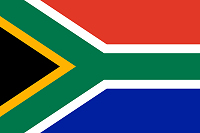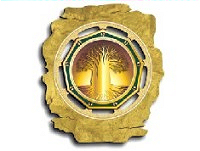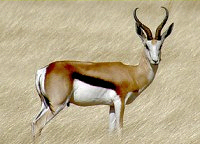 |
||
Quick guide to the national symbols of South AfricaHere's a quick guide to the national symbols of South Africa, from the flag, coat of arms and national orders to the animals and plants the country holds dear. Find out what that image means that appears on a South African birth certificate, passport, R5 coin and other official documents. Find out what the words "!ke e: /xarra //ke mean" mean and whose language that is. Find out what the South African Springbok, Blue Crane, Giant Protea and real Yellowwood have in common. INTRODUCTION
INTRODUCTION
NATIONAL ANTHEM NATIONAL FLAG NATIONAL COAT OF ARMS NATIONAL ORDERS NATIONAL ANIMAL AND PLANT SYMBOLS  The number one national symbol of the new South Africa Source: African National Congress - National symbols of South Africa Introduction,... 1994 is the year that marks the birth of a new South Africa, the birth of the “Rainbow nation”. A mix of many cultures making a new start on the road of true democracy. It was the year of far-reaching and often fundamental changes. It was also the year of a brand-new constitution, designed to heal the wounds of former separation and injustice and unite all South Africans into a new nationhood.  Union buildings in Pretoria, official seat of the South African government, also housing the office of the President of South Africa copyright © South African tourism - National symbols of South Africa After the 1994 elections, South Africa?s national identity changed a lot. Instead of having four provinces and a few homelands, there were now nine provinces. The national symbols changed with a new anthem, flag, coat of arms, national awards. And even some of the national sporting teams were renamed. Public holidays also changed after 1994. Some of the old holidays were left out, and new ones were added.  National flag of South Africa National symbols of South Africa In the emerging new South Africa, the change of its national symbols and emblems was a highly emotional issue. What flag should flap above the inauguration of the country's first black President? What anthem can whites and blacks possibly sing with shared enthusiasm after centuries of hostility? What coat of arms will grace the buttons on the tunics of the new, post-apartheid army? Not everything changed. Symbols like the national bird, tree, flower and animal have remained. << top of page National Anthem,...  Enoch Sontonga, co-composer of South Africa’s new national anthem National symbols of South Africa South Africa's national anthem is a combined version of ?Nkosi Sikelel' iAfrika? (?Lord, bless Africa? in English) and ?Die Stem van Suid-Afrika? (?The Call of South Africa? in English). The words of ?Die Stem? were written by CJ Langenhoven in 1918, and the music composed by the Reverend M.L. de Villiers in 1921. ?Nkosi Sikelel' iAfrika? was composed in 1897 by Enoch Sontonga, a Methodist mission school teacher. read more >> << top of page National Flag,... The national flag of the Republic of South Africa was adopted on Freedom Day, 27 April 1994, and first flown on 10 May 1994, the day Nelson Mandela was inaugurated as president. The central design of the flag, beginning at the flag-pole in a V form and flowing into a single horizontal band to the outer edge of the fly, can be interpreted as the convergence of diverse elements within South African society, taking the road ahead in unity.  South Africa’s new national flag National symbols of South Africa read more >> << top of page National Coat of Arms,... A national Coat of Arms, or state emblem, is the highest visual symbol of the State. The Coat of Arms is also a central part of the Great Seal, traditionally considered to be the highest emblem of the State. Absolute authority is given to every document with an impression of the Great Seal on it. This means that it has been approved by the President of South Africa. South Africa’s Coat of Arms was launched on Freedom Day, 27 April 2000. The change reflected the Government's aim to highlight the democratic change in South Africa and a new sense of patriotism.  South Africa’s national coat of arms National symbols of South Africa read more >> << top of page National Orders,... National orders are the highest awards that a country can bestow on its citizens or on eminent foreigners. South Africa's new national orders, first awarded by President Thabo Mbeki in 2002, reflect the inclusiveness and diversity of a democratic South Africa, our people and our place in the African continent and in essence, the spirit of the new South Africa.  Order of the Baobab National symbols of South Africa read more >> << top of page National Animal and Plant symbols,... The country's national animal is the Springbok, which also gives its name to the South African rugby team , fondly (and sometimes not so fondly) known as the Boks. The Springbok (Antidorcas marsupialis) gets its common name from its characteristic jumping display, “pronk” in Afrikaans. The animal stands 75cm high and weighs about 40kg.  National animal of South Africa, the Springbok National symbols of South Africa read more >> Top of Page |
|
|
|
|
||



